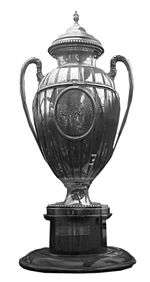Copa Aldao
|
The trophy awarded to champions | |
| Founded | 1913 |
|---|---|
| Abolished | 1955 |
| Region |
Argentina Uruguay |
| Number of teams | 2 |
| Most successful club(s) |
(5 titles) |
The Copa Ricardo Aldao (English: Ricardo Aldao Cup), popularly called Campeonato Rioplatense and Copa Río de La Plata, was a football club competition contested annually, albeit irregularly, between the league champions of Argentina and Uruguay. The cup is one of several inter-South American club competitions that have been organised on the continent. The first competition was scheduled for the 1913 season (although it was never played) and the last in 1955 (actually played in 1959, no champions proclaimed). The Copa Ricardo Aldao is seen today as the first stepping-stone into the creation of Copa Libertadores. In 2009, when the IFFHS proclaimed Peñarol of Montevideo as the best South American team of the 20th century, they took into consideration the Copa Aldao and other international club tournaments played in South America before the beginning of Copa Libertadores in 1960.[1] In August 2015 a CONMEBOL's article described Aldao Cup as the first official international professional football cup in South America.[2]
History
Friendly matches were common between clubs from Argentina and Uruguay in the early 1900s due to the close proximity of the nations. Inevitably, a match to decide which national champion was the best formulated; the trophy of the competition was donated by Ricardo Aldao, then president of both, club Gimnasia y Esgrima (BA) and dissident association "Federación Argentina de Football". As such, the competition was named after his donation. The first edition, organized in 1913, was to be contested between Estudiantes from Argentina and River Plate from Uruguay. However, the match was suspended due to heavy rain and never rescheduled.[3] The first champion of the competition was not crowned until 1916, when Nacional of Montevideo beat Racing de Avellaneda 2-1.
Originally, a single-legged format was adopted, with the match played in Argentina and Uruguay in alternative year.[3] But in 1940, Boca Juniors left the field when the match was at a draw of 2-2. The title was awarded to Nacional at first, yet later on both associations did not defined clearly the champion of this year.[3] Asociación Uruguaya de Fútbol (AUF) and Argentine Football Association (AFA) studied the situation on 22 January 1941, and announced that a two-legged format would be adopted in the following seasons.[3] The finals should be disputed before the beginning of the next season. Only players that had been part of the domestic champion squads could be included.[4] Since then, the competition was played two-legged exception made of the 1942 edition, when the second leg was not played and the trophy was not awarded.
Schedule problems forced teams of both countries to quit the Aldao Cup during the 1950s,[2] thus the competition was discontinued until 1959. One last attempt was made to rekindle the championship in 1955 in a match between Nacional and River Plate. However, the final was not disputed until four years later and the second leg was never played; therefore, the title was not officially proclaimed.[3] As a result to the schedule congestion of the growing national leagues (as well as the creation of the new continental club tournament, the Copa Libertadores de América) the Copa Aldao became redundant and was never played again.
Finals
Titles by club
| Team | Titles | Years won |
|---|---|---|
| | 5 | 1936, 1937, 1941, 1945, 1947 |
| | 3 | 1916, 1919, 1920 |
| | 2 | 1917, 1918 |
| | 2 | 1938, 1939 |
| | 1 | 1928 |
| | 1 | 1927 |
Titles by country
| Country | Titles | Winner teams |
|---|---|---|
| | 10 | River Plate (5), Racing (2), Independiente (2), San Lorenzo (1) |
| | 4 | Nacional (3), Peñarol (1) |
See also
Notes
- ↑ Argentine historian Miguel Bionda (Historia del Fútbol Platense) asserts that the 1913 edition was indeed played and Estudiantes de La Plata beat Uruguayan River Plate by 4-1. Likewise, the magazines Estudiantes del Mundo: 100 años de gloria, published by Argentine newspaper El Día in 2005, and the book Historia de Estudiantes de La Plata, edited by Diario Hoy in 1997 agreed with that. On the other hand, other sources, like the RSSSF and the Centro para la Investigación de la Historia del Fútbol state that the game was suspended due to rain.
- ↑ Title awarded to Racing as visiting team.[3]
- ↑ Replaced by two friendly matches between the champions of dissidents associations.[3]
- ↑ Nacional and Boca Juniors played a match at Montevideo which ended in a 2-2 draw. Boca Juniors left the field before the extra time, then the cup was initially awarded to Nacional, but eventually neither associations defined the champions.[3]
- ↑ Nacional beat River Plate 4-0 in the first leg played at Montevideo, but the cup was never officially awarded as the second leg was never disputed.[3]
- ↑ Replaced by two friendly matches between both finalists (Nacional and San Lorenzo).[3]
- ↑ River Plate beat Nacional 2-1 in the first leg played at Montevideo, but the cup was never officially awarded as the second leg was never disputed.[3]
References
- ↑ "Peñarol chosen as the South American club of the century". Buenos Aires Herald. 17 September 2009. Retrieved 24 March 2015.
- 1 2 "River Plate, ensancha sus vitrinas para seguir sumando copas" (in Spanish). Conmebol. 16 August 2015.
- 1 2 3 4 5 6 7 8 9 10 11 12 Campeonato Rioplatense - Copa Dr. Ricardo C. Aldao on RSSSF
- ↑ "Memoria y Balance 1941 - pp. 45-46". AFA. Retrieved 10 May 2015.
